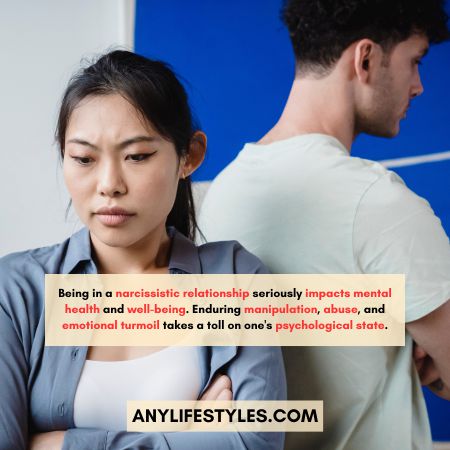Have you ever heard of any narcissistic relationship going strong? No, because it can never happen. Experiencing a relationship with a narcissist can be a tough and complicated road to navigate. It involves going through the 21 stages of a narcissistic relationship.
Understanding these stages is essential for those who have been or are currently in a narcissistic relationship. The journey starts with an enchanting phase but soon turns into a cycle of devaluation and manipulation.
Healing and rebuilding our self-worth begin with recognizing and understanding the 21 stages of a narcissistic relationship. In this article, we will outline the 21 stages that are commonly seen in narcissistic relationships.
Can Narcissists Feel Love?
Narcissists may believe they are experiencing love, but their understanding of love is often distorted and self-centered. They may engage in romantic relationships and show affection towards their partners, but their love is motivated by their own validation, control, and admiration needs.
Narcissists tend to view others as extensions of themselves and seek partners who will enhance their self-image. They may engage in love-bombing, showering their partner with affection and attention initially, but this behavior often fades over time as they lose interest or their needs change.

True empathy and emotional connection, which are crucial aspects of genuine love, are often lacking in narcissists. Ultimately, their self-centeredness and inability to truly understand and care for others make it challenging for them to experience love.
21 Stages Of A Narcissistic Relationship
Entering into a relationship is often seen as a beautiful journey, filled with love, compassion, and mutual understanding. However, not all relationships follow this idealistic path. Some people get caught up in a complicated web of a narcissistic relationship.
By learning about the 21 stages of a narcissistic relationship, we can gain insights into the tactics used by narcissists, the emotional abuse they inflict, and the impact it has on our well-being. Armed with this knowledge, we can set boundaries, seek support, and regain control over our lives.
Remember, not all narcissistic relationships will go through all of these stages or in the exact order. But knowing these patterns can help you recognize if something is wrong in your relationship. So, get ready to explore the eye-opening 21 stages of a narcissistic relationship that will feel like a turbulent ride.
1. The Seductive Phase – 21 Sages of a Narcissistic Relationship:
In the early stages of a narcissistic relationship, there is often a seductive and alluring phase that fascinates the partner. The narcissist, armed with their charm, and charisma creates an atmosphere of attraction and obsession, making the partner feel desired.
During this seductive phase, the narcissist uses various techniques to win over their partner. They may shower them with compliments, engage in grand gestures of affection, and exhibit an ability to fulfill their partner’s emotional needs.

2. Attraction and Idealization Phase:
The next stage after the initial seduction is the phase of attraction and idealization. During this stage, narcissist uses their charm and charisma to attract their partner. They give them lots of compliments, attention, and love, making them believe they have found the perfect match.
The narcissist presents a version of themselves that seems ideal, focusing on shared interests, values, and a promising future together. The partner feels incredibly special and loved. However, what they don’t realize is that this phase is just the beginning of a manipulative and controlling plan.
3. Love-Bombing and Excessive Adoration:
In this phase, the narcissist tries harder to win over their partner. They give an overwhelming amount of love, attention, and admiration, which is known as love bombing. They may use big gestures, expensive gifts, and constant compliments to make their partner feel dependent on them.
The narcissist makes their partner believe they are incredibly important, always praising them and making big promises for the future. However, behind all this affection, there is a manipulative tactic to exploit their partner’s vulnerable emotions.
4. Red Flags and Early Warning Signs:
It is crucial to recognize the early signs of narcissistic relationships that indicate potential harm. One important stage is to notice when red flags and warning signs start to appear. At first, the narcissist may seem charming and attentive, but as time goes on, certain behaviors become evident.

These red flags serve as indications of the narcissist’s true nature and their manipulative tendencies. It might include a constant need for admiration, a lack of empathy towards others, and a sense of entitlement. By identifying these signs earlier, individuals can protect themselves.
5. Manipulation and Control Tactics:
As a narcissistic relationship progresses, there comes the manipulation and control stage. Over time, the narcissist begins to employ manipulative strategies to gain control over their partner. One common tactic is manipulation, where they twist the truth and make their partner doubt their perception of reality.
This manipulation leaves the partner feeling confused, lost, and unsure of their sanity. It’s important to be aware of these signs to protect oneself in a narcissistic relationship.
6. Emotional Exploitation and Gaslighting:
As a narcissistic relationship unfolds, there is a troubling stage called emotional exploitation and gaslighting. The narcissist, fueled by an unquenchable thirst for control and power, manipulates their partner’s emotions to serve their selfish purposes.
They exploit their partner’s vulnerabilities and insecurities, using them as weapons to establish dominance and control. Gaslighting, a particularly harmful tactic employed by narcissists, involves distorting the truth and making their partner question their sanity.
7. Undermining Self-Esteem – 21 Stages of a Narcissistic Relationship:
In a narcissistic relationship, the gradual decline of self-esteem and confidence is a major stage that happens over time. The narcissist uses emotional manipulation, gaslighting, and hurtful behavior to break down their partner’s self-worth, making them feel smaller of themselves.
Narcissist purposefully undermines their partner’s value, belittles their achievements, and finds faults in everything they do, all to keep control and power over them.
8. The Destructive Cycle of Disapproval:
One of the stages that often arises in a narcissistic relationship is intense criticism and disapproval from the narcissistic partner. Initially, the narcissist appears charming and supportive, but as the relationship progresses, their true nature begins to surface.

They gradually increase their criticism towards their partner, finding faults in their appearance, behavior, and choices. The narcissist may degrade their partner, making them feel inadequate and constantly seeking their approval.
9. The Slow Erosion of Supportive Relationships:
A distressing stage that often occurs in a narcissistic relationship is the isolation of the person from their support systems. The narcissist seeks to control and manipulate their partner by cutting off their connections from friends, family, and other sources of support.
The narcissist person may question their partner’s relationships, create conflicts, or portray themselves as the only trustworthy and reliable person in their life.
10. Increase in Emotional and Verbal Abuse:
In a narcissistic relationship, there comes a stage where emotional and verbal abuse becomes more frequent and severe.
As time goes on, the narcissist’s desire for power and control grows stronger, resulting in more abusive behaviors, disrespecting, and manipulating their partner.
11. Recognizing Blame-Shifting Patterns:
The stage of blame-shifting and deflection is a common tactic employed by narcissists to avoid taking responsibility for their actions.
When confronted with their harmful behavior or their actions, narcissist deflects blame onto their partner, distorting the truth and shifting the focus away from themselves.

12. Signs of Triangulation and Jealousy:
In a narcissistic relationship, the stage of triangulation and jealousy often arises as the narcissist seeks to maintain control of their partner’s emotions.
Triangulation involves the narcissist introducing a third person into the relationship, creating a sense of competition and insecurity.
13. Cycles of Idealization and Devaluation:
A narcissistic relationship involves a stage of the recurring cycles of idealization and devaluation. The Narcissists idealize their partner, showering them with attention, love, and admiration. This phase creates a sense of euphoria and a false belief in the perfect nature of the relationship.
However, over time, the narcissist begins to devalue their partner, criticizing, belittling, and diminishing their worth. This rollercoaster of extreme highs and lows can be emotionally devastating for the partner.
14. Dehumanization and Objectification:
Within the different stages of a narcissistic relationship, there is a particularly distressing phase where the narcissist dehumanizes and objectifies their partner.
As the relationship progresses, the narcissist completely disregards the partner’s emotions, autonomy, and humanity, instead treating them as mere extensions of themselves.
15. Silent Treatment and Emotional Starvation:
In relationships with narcissists, it is quite common for them to use the silent treatment and emotional withdrawal as a way to control and punish their partner.

They purposefully ignore or avoid their partner in order to manipulate their feelings and maintain their sense of power.
16. Discarding and Abandonment:
One of the most painful stages in a narcissistic relationship is the discarding and abandonment phase. After a period of idealization, the narcissist begins to devalue their partner and may abruptly end the relationship without any explanation or closure.
This cruel act leaves the partner feeling rejected, confused, and emotionally devastated.
17. The Hoovering Phase – 21 Stages of a Narcissistic Relationship
Hoovering refers to the stage in a narcissistic relationship where the narcissist attempts to re-establish contact and regain control over their former partner. It involves manipulative tactics and false promises, aimed at luring the partner back into the toxic cycle.
The narcissist may use various strategies to initiate contact, such as sending messages, making grand gestures, or seeking sympathy.
18. Nurturing Mental Health After Narcissistic Abuse:
Being in a narcissistic relationship can have severe consequences for an individual’s mental health and overall well-being. The prolonged exposure to manipulation, abuse, and emotional turmoil takes a toll on their psychological state.

The effects can be long-lasting and may require professional support to recover and rebuild.
19. Self-Reflection and Inner Healing:
After enduring the damaging effects of a narcissistic relationship, healing and rebuilding self-esteem are crucial steps toward recovering and regaining a sense of self-worth.
This stage involves self-reflection, self-care, and engaging in activities that promote personal growth and empowerment.
20. The Importance of Seeking Professional Help and Support:
Breaking from a narcissistic relationship is a crucial stage in regaining one’s life and well-being. It involves recognizing the toxic dynamics, gathering inner strength, and reaching out for support.
Seeking professional help and building a support network are essential steps toward healing and moving forward.
21. Establishing Healthy Boundaries:
After breaking up from a narcissistic relationship, individuals have the opportunity to not only survive but thrive in their lives.
This stage involves reclaiming one’s identity, setting healthy boundaries, and embracing personal growth and happiness.
Conclusion – 21 Stages of a Narcissistic Relationship
A narcissistic relationship consists of different stages, and navigating through them can be emotionally turbulent. Recognizing the signs of narcissistic behavior early on and seeking professional assistance is crucial to prevent further harm.
With the right support, healing from abusive relationships becomes possible, and learning to prioritize one’s happiness becomes paramount. Initially, a narcissistic relationship may seem seductive and captivating, but it can quickly turn chaotic and destructive.
Taking care of oneself and seeking help are essential steps toward recovery. No matter which stage you are in, it is never too late to break free. With compassion and understanding, you can escape the cycle of abuse and find freedom.










